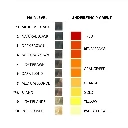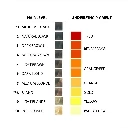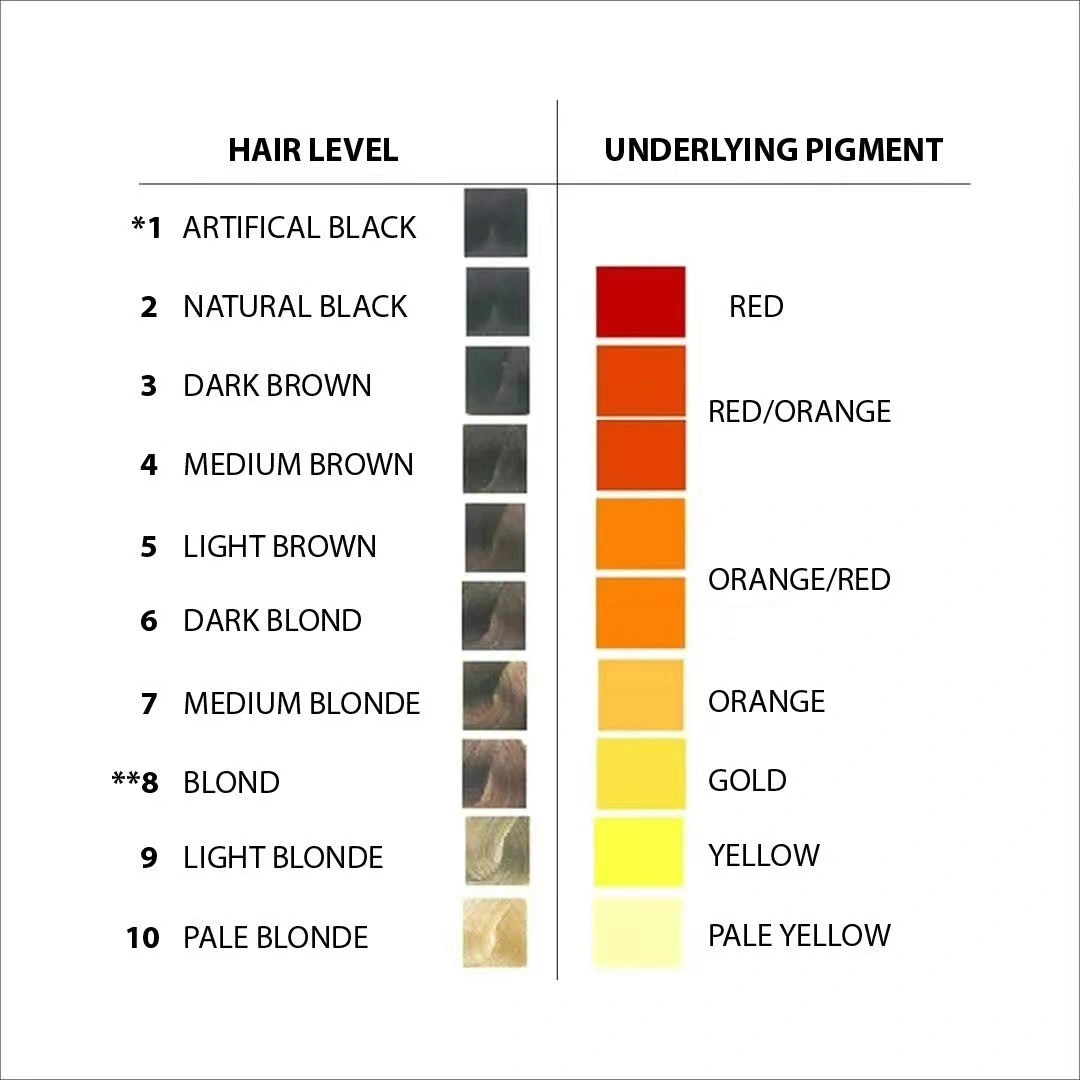HAIR COLOR and The COLOR WHEEL


cross-posted from: https://sh.itjust.works/post/32623445
> This hair color wheel visually represents the underlying pigments naturally present in human hair at different levels. These pigments are revealed when hair is lightened: > > Underlying Pigments by Hair Level: > - Level 2 (Darkest Brown/Black): Deep Red > - Level 3 (Dark Brown): Red > - Level 4 (Medium Brown): Bright Red > - Level 5 (Light Brown): Red-Orange > - Level 6 (Dark Blonde/Light Brown): Orange-Red > - Level 7 (Medium Blonde): Orange > - Level 8 (Light Blonde): Gold (Yellow-Orange) > - Level 9 (Very Light Blonde): Yellow > - Level 10 (Platinum Blonde): Pale Yellow > > ### Complementary (Opposite) Colors for Neutralization: > Every underlying pigment has an opposite (complementary) color on the color wheel. These opposite shades are used to neutralize unwanted warmth when toning or adjusting hair color: > > - Deep Red (Level 2) → Opposite: Green (Neutralizes dark red tones) > - Red-Violet (Level 3) → Opposite: Green (Balances red hues) > - Red (Level 4) → Opposite: Green (Cancels strong red undertones) > - Red-Orange (Level 5) → Opposite: Blue-Green (Neutralizes warm red-orange tones) > - Orange-Red (Level 6) → Opposite: Blue (Cancels orange-red warmth) > - Orange (Level 7) → Opposite: Blue (Neutralizes brassy orange tones) > - Gold/Yellow-Orange (Level 8) → Opposite: Violet-Blue (Balances warm golden hues) > - Yellow (Level 9) → Opposite: Violet (Tones down bright yellow tones) > - Pale Yellow (Level 10) → Opposite: Soft Violet (Gently cools down any remaining warmth for a platinum finish) > > How to Use This Wheel in Hair Coloring: > Understanding underlying pigments and their complementary colors is essential for achieving balanced, natural-looking hair color results. When lightening hair, unwanted warmth can be controlled by selecting the opposite shade on the wheel: > > - Want to neutralize brassiness? Use blue or violet-based toners. > - Want to enhance warmth? Choose a shade with gold, copper, or red tones. > - Going from dark to light? Expect underlying pigments to shift in this predictable order—and plan toning accordingly. > >
HAIR COLOR and The COLOR WHEEL

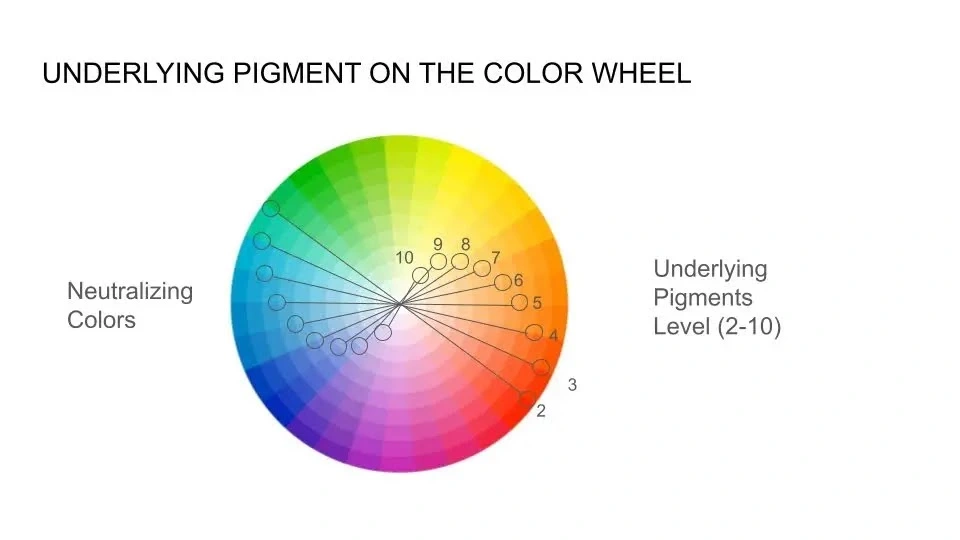
cross-posted from: https://sh.itjust.works/post/32623445
> This hair color wheel visually represents the underlying pigments naturally present in human hair at different levels. These pigments are revealed when hair is lightened: > > Underlying Pigments by Hair Level: > - Level 2 (Darkest Brown/Black): Deep Red > - Level 3 (Dark Brown): Red > - Level 4 (Medium Brown): Bright Red > - Level 5 (Light Brown): Red-Orange > - Level 6 (Dark Blonde/Light Brown): Orange-Red > - Level 7 (Medium Blonde): Orange > - Level 8 (Light Blonde): Gold (Yellow-Orange) > - Level 9 (Very Light Blonde): Yellow > - Level 10 (Platinum Blonde): Pale Yellow > > ### Complementary (Opposite) Colors for Neutralization: > Every underlying pigment has an opposite (complementary) color on the color wheel. These opposite shades are used to neutralize unwanted warmth when toning or adjusting hair color: > > - Deep Red (Level 2) → Opposite: Green (Neutralizes dark red tones) > - Red-Violet (Level 3) → Opposite: Green (Balances red hues) > - Red (Level 4) → Opposite: Green (Cancels strong red undertones) > - Red-Orange (Level 5) → Opposite: Blue-Green (Neutralizes warm red-orange tones) > - Orange-Red (Level 6) → Opposite: Blue (Cancels orange-red warmth) > - Orange (Level 7) → Opposite: Blue (Neutralizes brassy orange tones) > - Gold/Yellow-Orange (Level 8) → Opposite: Violet-Blue (Balances warm golden hues) > - Yellow (Level 9) → Opposite: Violet (Tones down bright yellow tones) > - Pale Yellow (Level 10) → Opposite: Soft Violet (Gently cools down any remaining warmth for a platinum finish) > > How to Use This Wheel in Hair Coloring: > Understanding underlying pigments and their complementary colors is essential for achieving balanced, natural-looking hair color results. When lightening hair, unwanted warmth can be controlled by selecting the opposite shade on the wheel: > > - Want to neutralize brassiness? Use blue or violet-based toners. > - Want to enhance warmth? Choose a shade with gold, copper, or red tones. > - Going from dark to light? Expect underlying pigments to shift in this predictable order—and plan toning accordingly. > >
HAIR COLOR and The COLOR WHEEL

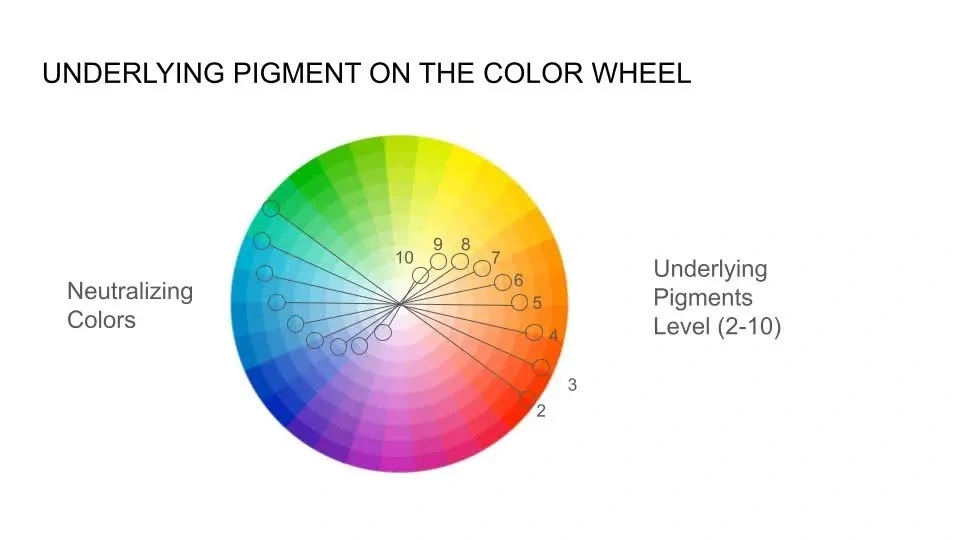
This hair color wheel visually represents the underlying pigments naturally present in human hair at different levels. These pigments are revealed when hair is lightened:
Underlying Pigments by Hair Level:
- Level 2 (Darkest Brown/Black): Deep Red
- Level 3 (Dark Brown): Red
- Level 4 (Medium Brown): Bright Red
- Level 5 (Light Brown): Red-Orange
- Level 6 (Dark Blonde/Light Brown): Orange-Red
- Level 7 (Medium Blonde): Orange
- Level 8 (Light Blonde): Gold (Yellow-Orange)
- Level 9 (Very Light Blonde): Yellow
- Level 10 (Platinum Blonde): Pale Yellow
Complementary (Opposite) Colors for Neutralization:
Every underlying pigment has an opposite (complementary) color on the color wheel. These opposite shades are used to neutralize unwanted warmth when toning or adjusting hair color:
- Deep Red (Level 2) → Opposite: Green (Neutralizes dark red tones)
- Red-Violet (Level 3) → Opposite: Green (Balances red hues)
- Red (Level 4) → Opposite: Green (Cancels strong red undertones)
- Red-Orange (Level 5) → Opposite: Blue-Green (Neutralizes warm red-orange tones)
- Orange-Red (Level 6) → Opposite: Blue (Cancels orange-red warmth)
- Orange (Level 7) → Opposite: Blue (Neutralizes brassy orange tones)
- Gold/Yellow-Orange (Level 8) → Opposite: Violet-Blue (Balances warm golden hues)
- Yellow (Level 9) → Opposite: Violet (Tones down bright yellow tones)
- Pale Yellow (Level 10) → Opposite: Soft Violet (Gently cools down any remaining warmth for a platinum finish)
How to Use This Wheel in Hair Coloring: Understanding underlying pigments and their complementary colors is essential for achieving balanced, natural-looking hair color results. When lightening hair, unwanted warmth can be controlled by selecting the opposite shade on the wheel:
- Want to neutralize brassiness? Use blue or violet-based toners.
- Want to enhance warmth? Choose a shade with gold, copper, or red tones.
- Going from dark to light? Expect underlying pigments to shift in this predictable order—and plan toning accordingly.
Welcome to the Hair Colour Community
A place to discuss everything and anything regarding hair colour and hair colouring. Professional and Commercial.
